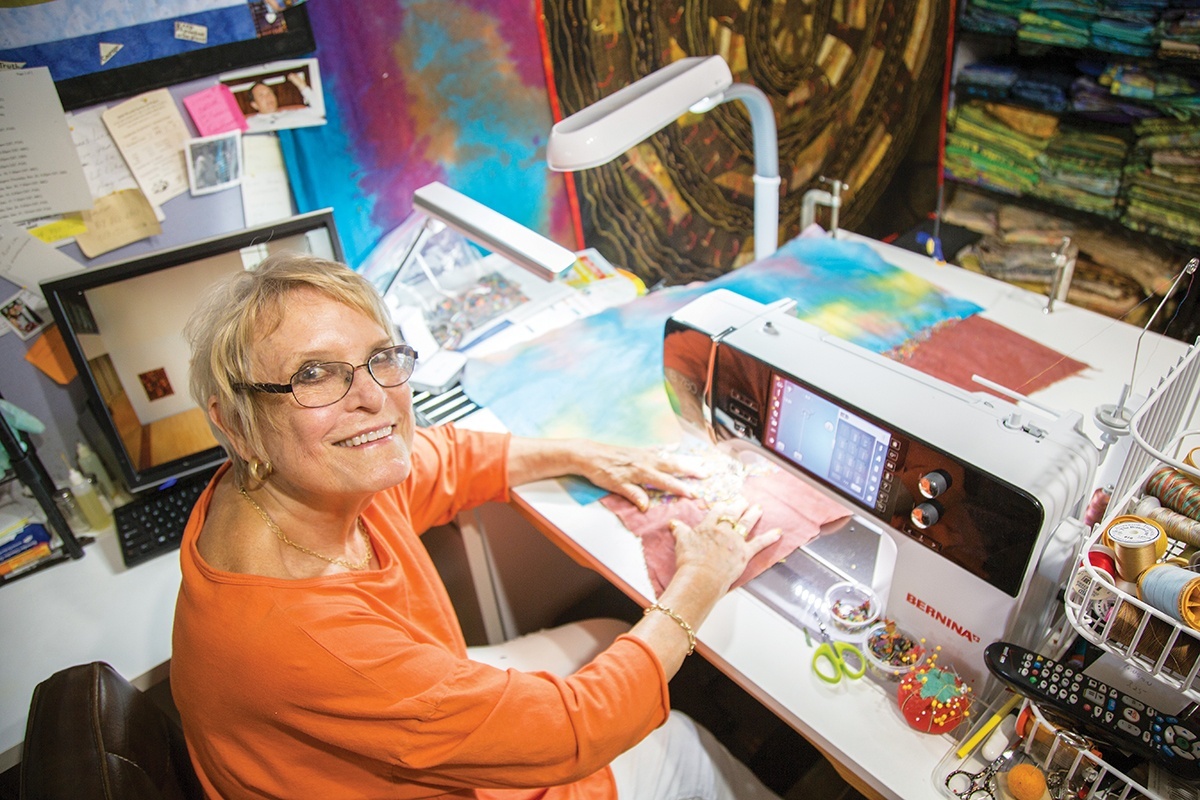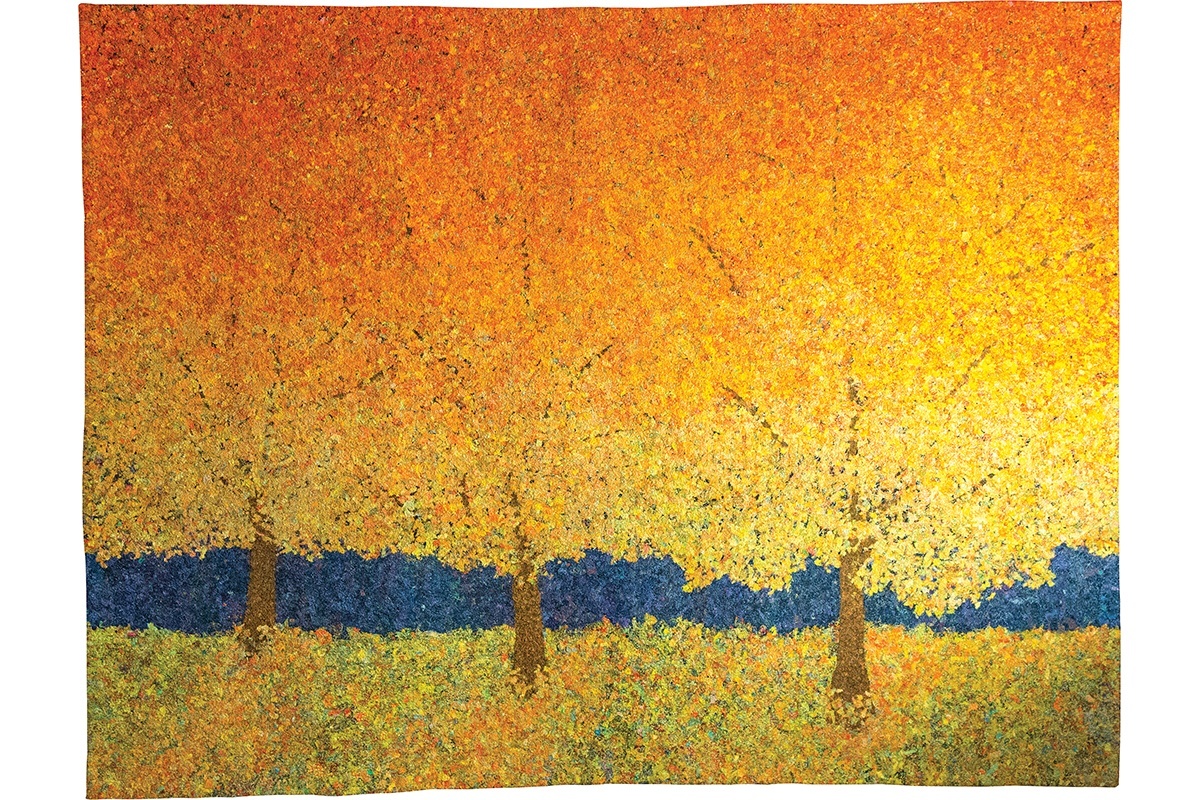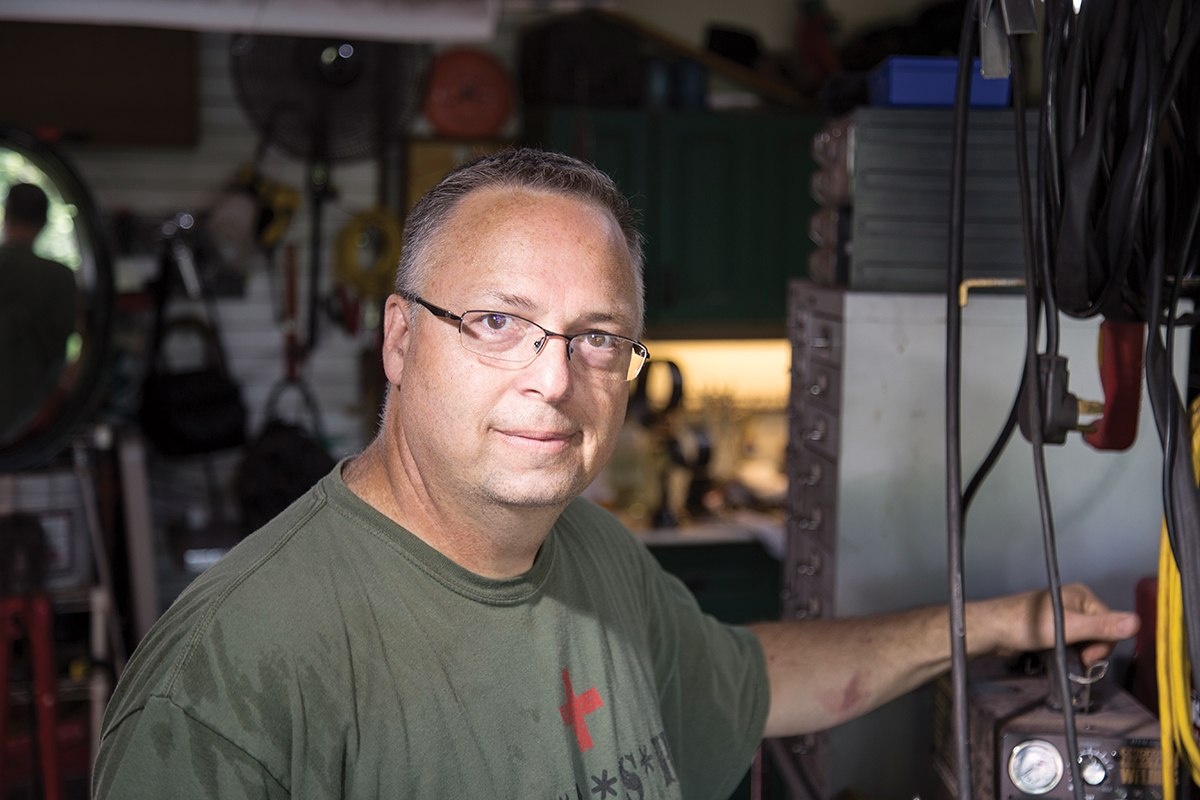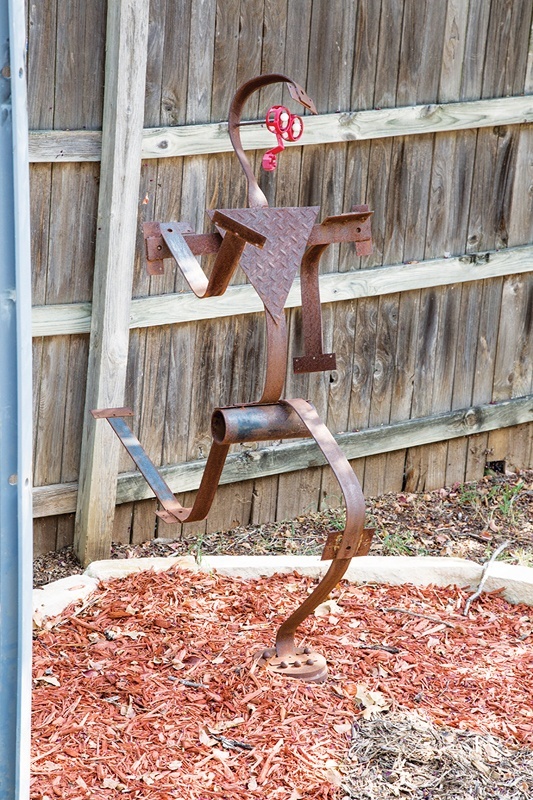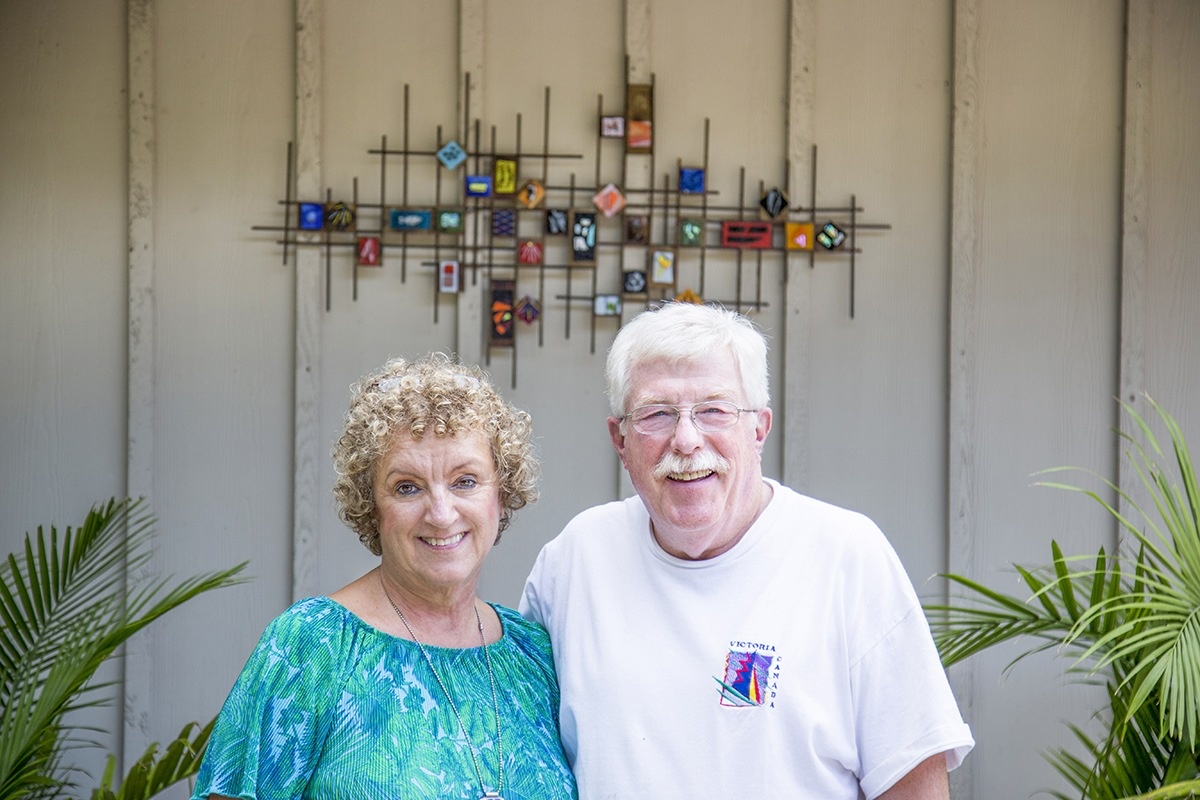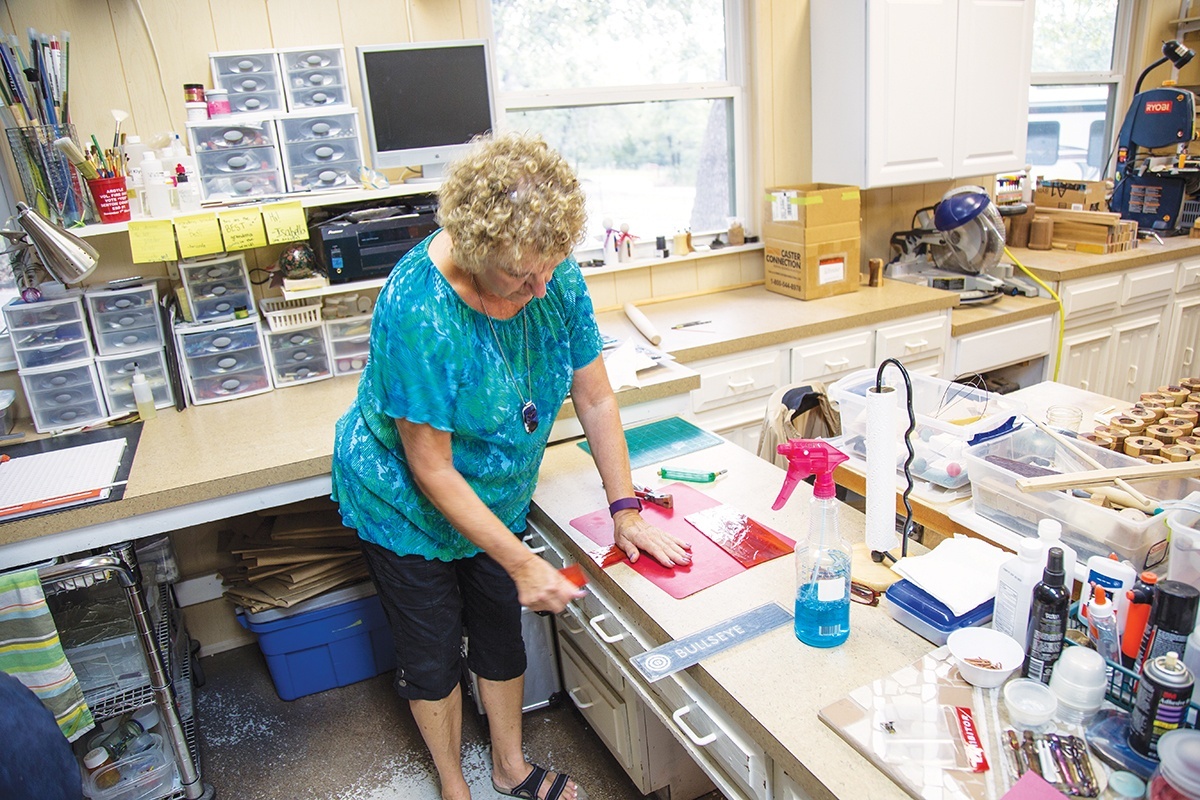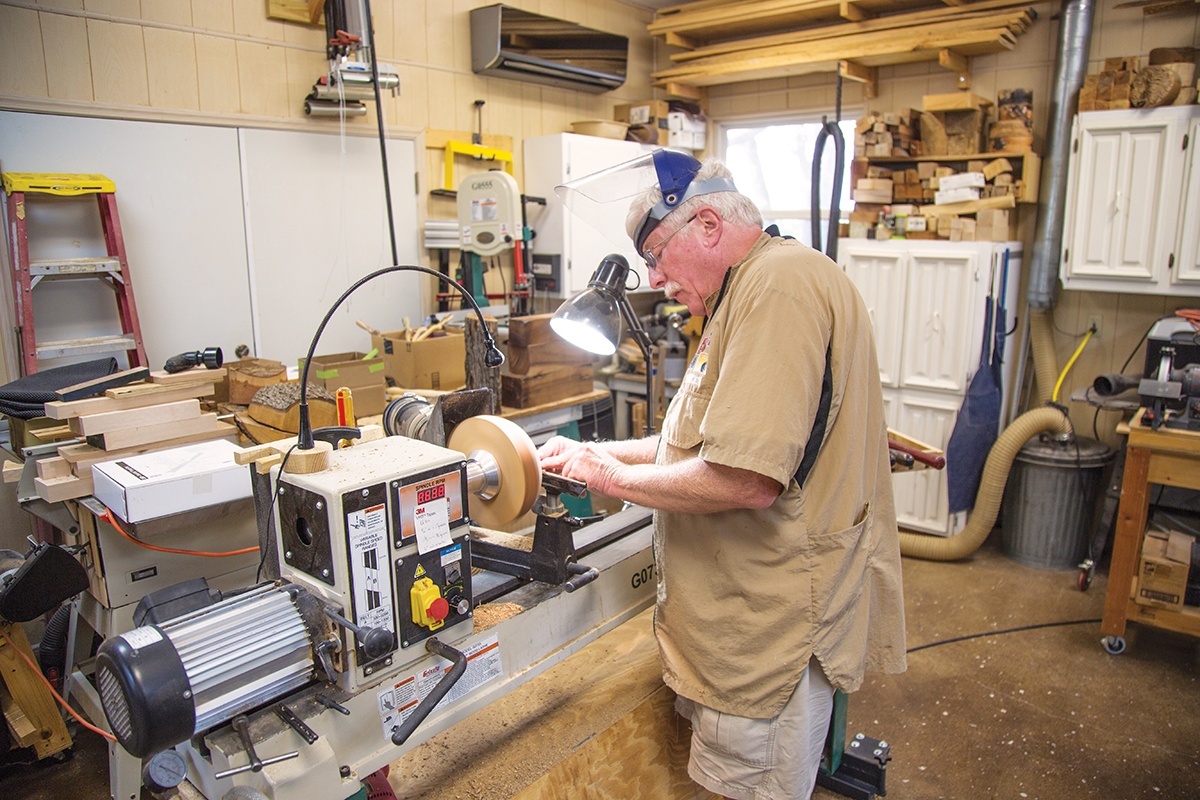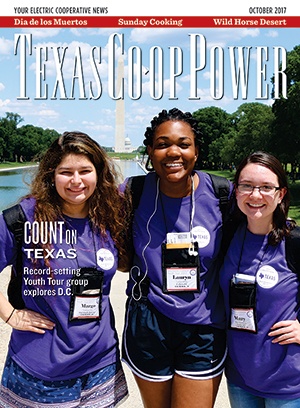Editor’s Note: The 16th Annual Artists Studio Tour by the Cross Timbers Artists Guild is scheduled November 11-12 in North Texas. Below are profiles of three of the more than 20 artists whose artworks and creative process will be on display. “It’s the best kept secret in Denton County,” said Flower Mound fiber artist Barbara Hartman. “The whole point of the tour is letting people know there are working artists in their neighborhood.” For more details about the tour, please visit crosstimbersarts.com.
In Highland Village, Welding Plus Wind Creates Sculptures in the Sky
Rebar and roof flashing swivel and swing with a gust of wind.
It is this precise movement Daren Fagan envisions for the kinetic sculptures that surround his Highland Village home.
He doodles daydreams on a notepad or writes them in chalk on his metal work bench. The artist then grabs road construction recyclables and combines them with unused gears and metal parts from a nearby shelf. Some pieces work, others don’t as he steadily configures just the right combination.
Once satisfied, he welds vision into reality.
“It just sort of flows, and I go with it,” Daren said.
A welding machine, tucked inside his garage, serves as Fagan’s veritable paint brush. Grabbing pieces tucked on shelves or inside bowels as he works, the sculptor’s ideas take shape.
“There’s nothing glamorous about the manufacturing process,” he said.
A collection of rebar sits in Daren’s front yard, salvaged from Interstate 35E reconstruction. A donated bowling ball doubles as a face of one creation; swirling saltwater fishing swivels add to another.
“I’m channeling myself,” he said. “They are imperfect like me.”
His work is in yards and homes of fellow artists and soon will be on the lawn of the MCL Grand Theater in Lewisville.
The Greater Lewisville Arts Alliance hired Daren to create a kinetic sculpture for the corner of Main and Charles streets. When finished, the artwork will stand 20 feet tall with moving pieces of metal in the form of a purple flower as a nod to the city’s purple martin logo.
Daren showed his first piece six years ago with the Texas Sculpture Association. Wind or a light push moves a metal figure back and forth, mimicking a jogger’s motion. He calls it “The Running Man.”
“In the evenings, I’m pretty dirty so I sit in the veg garden,” Daren said, referring to a backyard patio with chairs and the “Angel of Time” sculpture that, with lights, casts shadows on a wooden fence at night.
He hopes to open a gallery soon and is prepping for a solo show at the MCL Grand from mid-September to mid-October.
“Now it’s a matter of getting it out where people can see it.”
Sewing the Seeds of Art: Flower Mound Quilter ‘Paints’ With Scraps
Pinkie-sized pieces of material transform into quilted art under Barbara Oliver Hartman’s sewing needle.
Using a technique refined in the past 25 years, the Flower Mound artist tosses a handful of multi-hued fabric bits atop a hand-dyed background. A free-style stitch on the sewing machine allows her a broad range of motion.
“It makes it more organic,” Barbara said. “It unifies it, gives it continuity and all I’m doing is throwing it down.”
The seamstress stores bits of matching materials in separate bins like a painter’s palette. As in oil painting, she creates layers, letting her imagination mingle with materials, thread and needle to create each piece. If something doesn’t quite work, she sews on another layer.
“It’s pretty painterly,” she said, standing in front of a large autumn scene depicting thousands of leaves fluttering to the ground. “There can be three to five layers on the surface.”
Work by the renowned quilter is recognized across the country. A Quilt National 2015 People’s Choice Award is one of many honors Barbara has received in more than 30 years of quilting. In June, she captured the People’s Choice Award in the Visual Arts Society of Texas show in Denton.
But her heart prefers the process more than prizes.
A trio of quilts in a guest bedroom were created after 9/11. With safety on her mind, Barbara used safety pins in her designs titled “Are We Safe” and “Safety First.” She sewed one quilt by hand as she sat with an ailing sibling.
“Everything to me is solving a problem,” she said. “You can express yourself, capture things you are feeling.”
“Trippy,” one of her geometric designs, is in one show while others wing their way to other galleries. And, after winning a sewing machine as a prize, she’ll often have simultaneous projects.
“When I’m working on something, I often do more than one at a time,” she said.
Art appreciation comes naturally with a family of artists—her mother, a dressmaker and owner of her own shop, introduced a 5-year-old Barbara to the art of sewing.
Her hometown of Yuma, Ariz., also influences her work, which tends to include warmer colors with a southwestern flair.
However, Barbara is heading in a new direction, switching from tree scenes depicting autumn seasons to impressionist methods.
She is ready to let her inner painter run free.
“How lucky am I that I get to do this?” she said.
A Studio Full of Skills: Argyle Couple Use Shared Space to Master Art Forms
Suely Lohr blends multi-hued glass into art while her husband works with wood – both in the same Argyle studio.
Tools of the couple’s individual trades tell the story.
Plastic bins of colorful glass fill shelves on one side. Lathes and woodturning chisels sit atop movable carts on the other. Two kilns stand in the center.
“When it gets a little dusty in here, I won’t work,” Suely said, referring to the inevitable wood shavings that are part of a woodturner’s craft.
In turn, Tom Lohr trained to keep the specialized kilns working to save his wife time and money.
A glass fusion class 12 years ago started Suely down the path of piecing glass fragments into artistic designs. In her first try, she placed glass on a steel frame. In the kiln, the glass draped, creating a vase.
“Glass is so versatile,” she said.
From sheets to shards, Suely layers each project to create a specific look. Then she fires them in kilns, using temperature to add the finishing touches. Glass requires lots of air and about 1,600 degrees to melt.
“You can get different effects with temperatures,” she said. Lower temperatures create a layered look, retaining some of the original shapes and textures. The higher the temperature, the flatter the glass.
A pencil-sized tool with diamond tip scores glass. A quick snap and one piece becomes two. “It breaks easily,” she said.
From flattened wine bottles and jewelry to mosaics and sink basins, Suely transforms the brittle substance into an object of beauty.
For Tom, a line of antique-style wooden pepper mills awaits finishing touches. Tom uses different woods for a segmented look. Topped with antique hardware, the pepper mesqmills are popular gift items, especially for those who enjoy cooking.
Demonstrating how the lathe works, Tom grabs a piece of mesquite and shows how tree growth patterns decorate the outside. On the bowl’s edge, he leaves a wedge from the tree bark.
Tom enjoys working with mesquite–each artwork slightly different depending on where the tree grew.
“It’s the soil that makes it different,” he said.
The couple combine their talents on some projects, and they also share them with future artists when they teach their grandchildren a bit about their respective crafts.
“It’s fun when they come and learn,” Suely said.
The kids recently made wind chimes with both wood and glass–a combination that truly reflects their grandparents.
